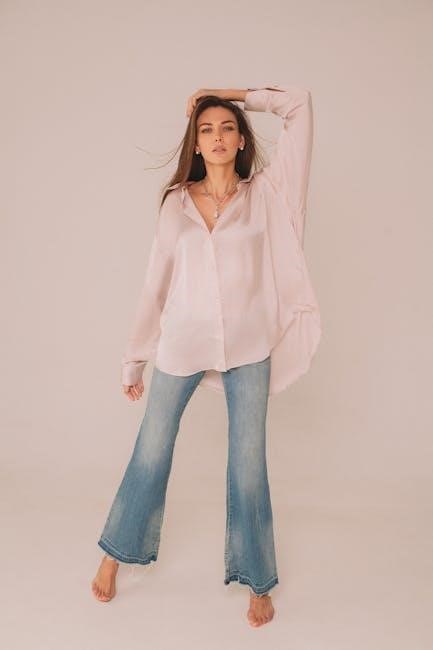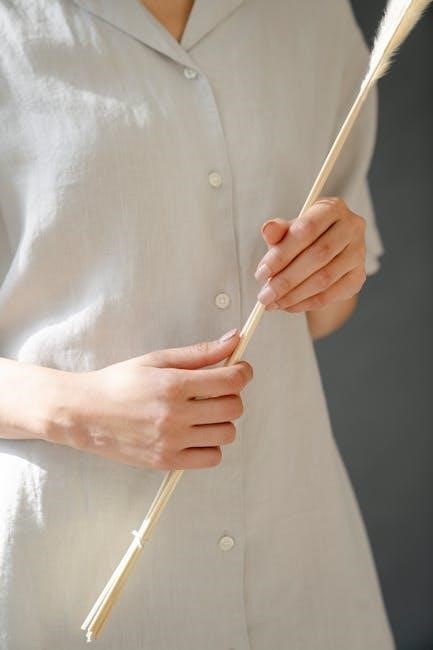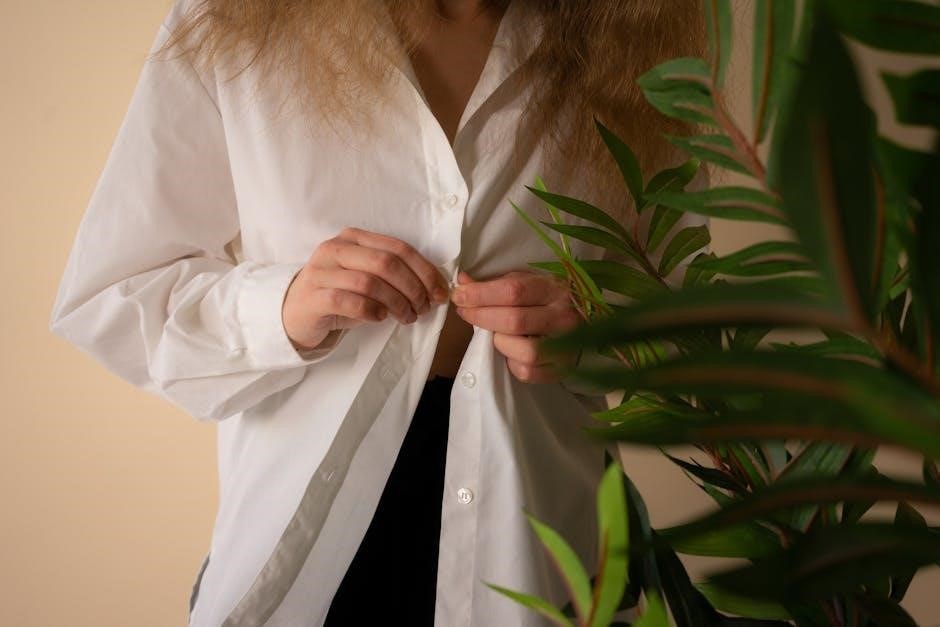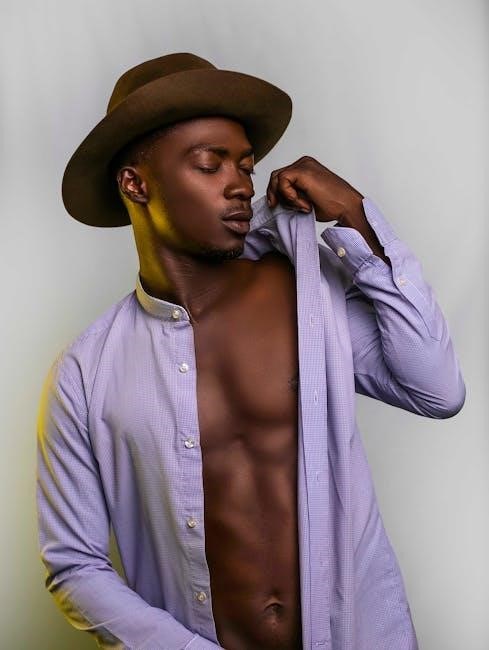A button-down shirt’s perfect fit depends on accurate measurements, style choices, and fabric considerations․ This guide helps you navigate sizing, ensuring comfort and confidence in your selection․
Importance of Proper Fit in Button-Down Shirts
A proper fit in a button-down shirt is essential for both style and comfort․ It ensures the shirt complements your body shape, creating a polished appearance while allowing ease of movement․ A well-fitting shirt avoids issues like gapping buttons or restrictive tightness, which can be uncomfortable and unflattering․ Whether for casual or formal occasions, the right fit enhances confidence and versatility․ Ill-fitting shirts can compromise functionality, such as difficulty in buttoning or a boxy, unflattering silhouette․ Achieving the perfect balance ensures the shirt drapes smoothly, accentuating your physique without feeling too loose or constricting․ Proper fit is key to making the most of this timeless wardrobe staple․
Overview of Button-Down Shirt Styles
Button-down shirts are available in various styles, catering to different preferences and body types․ Classic fits offer a traditional, relaxed silhouette, while slim-fit options provide a more tailored look․ Oversized shirts are ideal for a casual, laid-back vibe․ Women’s styles often feature unique cuts, such as fitted waists or V-necks, to flatter the female form․ Oxford shirts are a popular choice for their versatility, suitable for both formal and casual settings․ Additionally, plus-size options ensure inclusivity, offering comfort and style for all body types; Each style is designed to enhance comfort and confidence, making button-down shirts a versatile wardrobe essential for any occasion․

Understanding Measurements for Button-Down Shirts
Accurate measurements are key to a perfect fit․ Neck, chest, waist, sleeve, and shoulder measurements ensure comfort and style, guiding you to the ideal button-down shirt size․
Neck Size Measurement
Measuring your neck accurately is crucial for a comfortable button-down shirt fit․ To measure, wrap a flexible tape measure around the base of your neck, where the collar sits․ Keep the tape snug but not tight, ensuring it’s parallel to the floor․ Note the measurement in inches, typically ranging from 13 to 19 inches for men․ For women, sizes may vary, but the method remains the same; Add half an inch to your measurement to account for comfort and ease of movement․ This ensures the collar won’t be too tight or too loose, providing the perfect fit for your button-down shirt․
Sleeve Length Measurement
Measuring sleeve length ensures your button-down shirt fits perfectly․ Start by placing your arm straight out to the side, with your elbow slightly bent․ Use a flexible tape measure to run from the center back of your neck, over your shoulder, and down to your wrist bone․ For men, standard sleeve lengths range from 32 to 37 inches, while women’s sizes typically range from 23 to 30 inches․ Ensure the shirt’s sleeve reaches just past your wrist when your arm is relaxed․ Proper sleeve length prevents the shirt from appearing too short or overly long, enhancing both comfort and style․
Chest Measurement
Accurate chest measurement is crucial for a comfortable and flattering fit․ To measure your chest, place a flexible tape measure under your arms, across the fullest part of your chest, and level it around your back․ Ensure the tape is snug but not tight․ For men, chest measurements typically range from 38 to 50 inches, while women’s measurements range from 30 to 42 inches․ Compare this to the shirt’s size chart to determine the best fit․ A well-fitted chest ensures the shirt isn’t too tight or boxy, allowing for freedom of movement and a polished appearance․
Waist Measurement
The waist measurement is essential for ensuring a tailored fit, especially for women’s button-down shirts․ To measure your natural waist, wrap a flexible tape measure around the narrowest point of your torso, typically just above the hipbone․ Keep the tape level and snug but not tight․ For men, the waist measurement is often slightly smaller than the chest size, while for women, it varies based on body type․ When choosing a shirt, compare your waist measurement to the size chart to ensure a comfortable and flattering fit that complements your body shape without feeling restrictive or overly loose․
Shoulder Measurement
Shoulder measurement is crucial for a balanced fit in button-down shirts․ To measure, place the tape across the back, from the tip of one shoulder to the other, keeping it level and parallel to the floor․ Ensure the tape is not too tight or loose․ Proper shoulder fit prevents the shirt from sagging or feeling restrictive․ For men, shoulder measurements typically range from 40 to 46 inches, corresponding to sizes 14 to 16․ For women, measurements are slightly smaller, varying by style and brand․ Accurate shoulder measurement ensures the shirt sits smoothly, contributing to a polished and comfortable appearance․ Always refer to the size chart for precise guidance․

Key Considerations for Choosing the Right Size
Fit style, fabric type, and body type are critical factors․ Slim, standard, or oversized fits cater to different preferences․ Fabric stretch and drape affect comfort and appearance․
Standard Fit vs․ Slim Fit vs․ Oversized Fit

A standard fit offers a classic, relaxed silhouette, suitable for most body types․ Slim fit shirts are tailored closer to the body, ideal for those with lean builds․ Oversized fits provide a loose, comfortable style, often chosen for a trendy or casual look․ Each fit caters to different preferences and body types, ensuring comfort and confidence․ Measure carefully to determine the best fit for your frame․ Consider your lifestyle and personal style when selecting between these options to ensure the perfect balance of comfort and aesthetics․ Proper fit enhances both appearance and comfort, making it essential to choose wisely․

Fabric Type and How It Affects Fit
Fabric type significantly impacts the fit of a button-down shirt․ Cotton and Oxford cloth are popular choices, offering a structured yet breathable fit․ Tencel blends provide a softer, more drapey feel, while linen is ideal for a relaxed, summer look․ Thicker fabrics like flannel create a bulkier fit, whereas lightweight fabrics like voile offer a slimming effect․ Stretch fabrics ensure flexibility, while non-stretch fabrics maintain a crisp shape․ Consider your lifestyle and preferences when selecting fabric, as it influences both comfort and appearance․ The right fabric ensures a flattering fit, making it a crucial factor in choosing your perfect button-down shirt․
Common Button-Down Shirt Styles for Different Body Types
Button-down shirts come in styles tailored to various body types․ For petite frames, slim-fit shirts with shorter sleeves create a balanced look․ Broad-shouldered individuals benefit from classic Oxford shirts with a structured fit․ Those with larger busts can opt for V-neck or tailored button-downs to elongate the torso․ Plus-size individuals often find comfort in oversized or boyfriend styles, which offer a relaxed fit․ Taller individuals can choose longer sleeves and hemlines for proportion․ Understanding your body type and matching it with the right style ensures a flattering and comfortable fit, making button-down shirts versatile for all shapes and sizes․

Men’s Button-Down Shirt Size Guide
This guide provides detailed size charts and tips for men to find their perfect fit, ensuring comfort and style in every button-down shirt․

Men’s Size Chart: Neck, Chest, Waist, Sleeve Measurements
Men’s button-down shirts are sized based on neck, chest, waist, and sleeve measurements․ Neck sizes range from 13 to 19 inches, increasing by half-inch increments․ Chest measurements typically correspond to the shirt’s width, ensuring a comfortable fit without being too tight or loose․ Waist measurements are taken at the narrowest point, ensuring the shirt sits well on the body․ Sleeve length is measured from the center back of the neck to the wrist, providing a tailored look․ Referencing a size chart ensures accuracy, helping men choose the best fit for their body type and style preferences․
How to Measure Your Neck for the Perfect Collar Fit
To measure your neck for the perfect collar fit, use a flexible tape measure․ Place it around the base of your neck, where the collar would naturally sit, ensuring it’s level and not too tight or loose․ Stand up straight, look straight ahead, and relax your shoulders․ The tape should feel snug but not constricting․ Take note of the measurement in inches, rounding to the nearest half-inch for accuracy․ This measurement corresponds to the collar size in men’s shirts, ensuring a comfortable and tailored fit․ Proper neck measurement is essential for a shirt that buttons smoothly and lies flat against the body․
Understanding Sleeve Length for Different Body Types
Sleeve length is crucial for a balanced fit․ For shorter individuals, shorter sleeves create proportion, while taller individuals benefit from longer sleeves․ Measure from the center back of the neck to the wrist with arms relaxed․ Petite frames (under 5’4″) often prefer sleeves ending just above the hip, while taller individuals (over 6′) need sleeves reaching the wrist․ Broader shoulders may require longer sleeves for coverage, and longer arms need extended lengths for comfort․ Slim-fit shirts have tailored sleeves, while oversized styles offer a relaxed fit․ Proper sleeve length ensures functionality and aesthetics, avoiding a too-short or overly bulky appearance․
Women’s Button-Down Shirt Size Guide
Sleeve length is tailored to flatter various body types․ Petite frames suit shorter sleeves, while taller individuals benefit from longer lengths․ Measure from the neck’s center back to the wrist; Broader shoulders may need extended sleeves, and longer arms require additional length for comfort․ Slim-fit shirts offer a streamlined look, while oversized styles provide a relaxed fit․ Proper sleeve length ensures both functionality and style, preventing a boxy or restrictive appearance․ This guide helps you choose the ideal sleeve length to enhance your silhouette and ensure a comfortable, polished fit․
Women’s Size Chart: Bust, Waist, Shoulder, Sleeve Measurements
This size chart provides detailed measurements for women’s button-down shirts, ensuring a tailored fit․ Bust measurements range from 32-48 inches, while waist measurements span 24-40 inches․ Shoulder measurements are 14-18 inches, and sleeve lengths vary from 22-26 inches․ Sizes correspond to these dimensions, offering options for classic, slim, or oversized fits․ Use a flexible tape measure to determine your size accurately․ For a perfect fit, ensure the shirt skims your body without restriction․ Compare your measurements to the chart to select the ideal size, balancing comfort with style․ Proper fit enhances both appearance and confidence, making this guide essential for choosing the right shirt․
Finding the Right Fit for Your Body Type
Finding the perfect fit for your body type involves understanding your proportions and selecting styles that flatter them․ Petite women should opt for shorter sleeves and tailored cuts to avoid overwhelming their frame․ Hourglass figures benefit from shirts with defined waistlines or darts for a cinched look․ For rectangular body types, details like pockets or curved hems can add shape․ Pear-shaped individuals should look for A-line styles or longer lengths to balance hips․ Plus-size women can choose oversized or relaxed fits with V-necks to elongate the torso․ Use size charts and fabric considerations to ensure comfort and confidence in your button-down shirt choice․
How to Measure Your Bust for the Best Fit
To measure your bust for a button-down shirt, wrap a flexible tape measure around the fullest part of your chest, keeping the tape level and parallel to the floor․ Ensure the tape isn’t too tight or too loose․ For women, this is typically measured while wearing a well-fitting bra․ Add 1-2 inches to your bust measurement for ease, depending on the desired fit․ Use this measurement to compare with size charts․ Note that some styles, like relaxed or oversized fits, may require less precision․ Always consider fabric stretch and shirt style, as darts or seams can affect how the shirt drapes across your bust․

Plus-Size Button-Down Shirt Options
Plus-size button-down shirts offer size-inclusive options, ensuring comfort and style․ Brands like Universal Standard and Ahiri provide sizes up to 38/40, with features like hidden buttons for a polished look․
Size-Inclusive Brands for Plus-Size Shirts
Several brands excel in offering size-inclusive button-down shirts, catering to diverse body types․ Universal Standard stands out with their commitment to size inclusivity, offering shirts from sizes 00/0 to 38/40․ Ahiri provides stylish options up to size 14, blending comfort with fashion․ Bonobos is another notable brand, offering slim and classic fits across a wide range of sizes․ These brands ensure that plus-size individuals can enjoy well-tailored, high-quality button-down shirts that flatter their figures without compromising on style or comfort․ Their designs often feature adjustments like hidden buttons to prevent gaping, enhancing both fit and aesthetics․
How to Ensure a Comfortable Fit in Plus Sizes
For a comfortable fit in plus-size button-down shirts, consider fabrics like cotton blends or Tencel for breathability and softness․ Look for features such as adjustable cuffs and darts for a tailored silhouette․ Opting for a relaxed or oversized fit can provide ease of movement․ Some brands incorporate hidden buttons on the placket to prevent gapping, enhancing both comfort and confidence․ Measuring accurately and referring to size charts ensures the best fit․ Pairing the shirt with pants or skirts that complement its length and style can also elevate comfort and aesthetics, making it a versatile addition to your wardrobe․
Common Fit Issues and Solutions
Addressing fit issues like gapping buttons, tight sleeves, or ill-fitting shoulders can be resolved through alterations or choosing styles that flatter your body type for a polished look․
How to Fix a Gaping Button Placket
A gaping button placket can be resolved by adjusting the fit around the chest or opting for shirts with darts or a tailored silhouette․ Additionally, selecting a smaller size or adding a button can provide a more streamlined look․ Tailoring services can also ensure a custom fit, eliminating unwanted gaps for a polished appearance․ Proper sizing and style choices are key to achieving a flawless finish in your button-down shirt․
Adjusting Sleeve Length for the Perfect Fit
Sleeve length is crucial for a polished look․ Measure from the center back of the neck to the desired cuff length․ For a tailored fit, ensure sleeves are proportional to your height and arm length․ Shorter sleeves suit petite frames, while longer sleeves flatter taller individuals․ Adjustable cuffs or roll-up styles offer versatility․ If sleeves are too long, consider tailoring or folding to create a streamlined appearance․ Proper sleeve length enhances both comfort and aesthetics, ensuring your button-down shirt looks and feels its best․ Always refer to size charts for accurate measurements to achieve the ideal fit for your body type․
Altering Shoulder Measurements for a Custom Fit
Shoulder measurements are key to ensuring a button-down shirt hangs properly․ Measure across the back from shoulder tip to shoulder tip for accuracy․ If the shoulders feel too wide, the shirt may look boxy; if too narrow, it can restrict movement․ For a custom fit, consider altering the shoulder seams or adjusting the pattern․ Common issues include shoulders that are too tight or too loose, which can be resolved by taking in or letting out the seams․ When buying, compare measurements to a well-fitting shirt to gauge the right fit․ Proper shoulder alignment ensures the shirt drapes naturally, enhancing comfort and appearance․ Tailoring can make a significant difference for a polished look․

Additional Tips for the Best Fit
Consider fabric type, as stretchy materials offer flexibility․ Use size charts effectively and account for shrinkage․ Personal style influences fit, ensuring comfort and confidence in your choice․
How to Use a Size Chart Effectively
Using a size chart effectively starts with taking accurate body measurements․ Compare your neck, chest, and sleeve measurements to the chart to find your best fit․ Consider fabric type, as stretchy materials may offer more flexibility․ Consider your personal style—slim-fit shirts require precise measurements, while oversized styles offer more leniency․ Always check the brand’s specific sizing guide, as sizes can vary․ If unsure, round up to the nearest size․ Double-check the chart for sleeve length and shoulder fit to ensure comfort․ Proper use of a size chart ensures a shirt that flatters your body, boosting confidence and style․
Washing and Shrinking Considerations
Proper care is essential to maintain the fit and quality of your button-down shirt․ Always check the care label for specific instructions, as fabrics vary․ Cotton shirts may shrink slightly, while synthetic blends resist shrinking․ Wash shirts inside out to protect buttons and collars from damage․ Use cold water to prevent shrinkage and color fading․ Avoid over-drying, as heat can cause fabrics to tighten․ Air-drying is recommended for natural fibers․ For wrinkles, steam instead of ironing to preserve the fabric․ Regular washing in hot water or aggressive drying can alter measurements, so gentle care ensures your shirt retains its fit and appearance over time․

Choosing the Right Brand for Your Fit Preferences
Selecting the right brand ensures your button-down shirt matches your fit preferences․ Brands like Bonobos and J․Crew offer slim-fit options, while others provide classic or oversized styles․ Consider your body type and how each brand tailors its shirts․ For example, Universal Standard caters to a wide range of sizes, including plus sizes, with a focus on comfort and inclusivity․ Always check the brand’s size chart and read reviews to understand how their shirts fit․ Fabric quality and construction also vary, so choose brands that align with your lifestyle and needs․ This ensures a flattering, comfortable fit that meets your personal style and preferences․ Researching brands can make all the difference in finding your perfect shirt․ Tailored choices lead to a better fit and enhanced confidence․
Finding the perfect button-down shirt requires careful measurement, style consideration, and brand awareness․ By following this guide, you’ll confidently select a shirt that flatters your body type and meets your personal style, ensuring both comfort and elegance in every occasion․
Final Tips for Finding Your Perfect Button-Down Shirt
Accurate measurements, understanding your body type, and style preferences are key․ Consider fabric breathability and comfort․ Experiment with fits to avoid boxiness or tightness․ Don’t hesitate to seek alterations for a custom fit․ Read reviews for sizing insights and opt for size-inclusive brands․ Layering potential and versatility should influence your choice․ Wash before wearing to account for shrinkage․ Confidence in your shirt comes from a balance of fit, quality, and personal flair, ensuring you look sharp in every setting․
